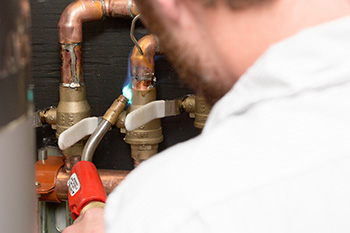Hot Work: Keep Your Building, Workers and Visitors Safe

According to the National Fire Protection Association (NFPA), 4,400 hot work-related structure fires occur each year. These fires caused an average of 12 civilian deaths, 208 civilian injuries and $287 million in direct property damage per year.1 To help prevent devastating property losses, it’s critical to carefully monitor the area any time hot work is performed.
What is Hot Work?
Hot work is a process involving open flames or that generates sparks. Processes such as welding grinding; thawing pipes; torch-applied roofing; and similar are all hot work operations. During this type of work, the sparks and heat produced can cause injuries or ignite a fire if not performed safely.
When most people think about hot work, they think metalworking shops, industrial welding operations and construction. However, hot work touches the lives of us all, mainly through installation, maintenance and repair operations. Businesses such as restaurants, retail shopping centers, office buildings and even residential structures require HVAC, plumbing and electrical systems to operate efficiently. Installing and maintaining these systems often requires hot work that may be completed by maintenance staff or contractors.
Some examples of service or repair jobs where hot work may be involved include:
- Hot water heater tanks
- Air conditioning units
- Electrical equipment (open circuits, wires, power bars, fittings)
- Power lines
- Gas lines
- Torch-applied roofing
Some work areas may be small or confined, which creates an even greater risk for fires when working with dangerous equipment or tools. If hot work is left unsupervised, fires can occur, causing property damage and threatening the lives of your staff, customers, or residents.
Hot Work Safety Tips
- Develop a program with written procedures for safe practices and record keeping any time hot work is performed
- Keep emergency numbers readily available in case of fire
- Consider temporary protection whenever possible, such as easily accessible fire extinguishers
- Identify employees and / or additional security rounds for fire watches
- Enforce a strict “no smoking” policy in and around hot work areas
Hot Work Program Implementation
To help minimize fires and potential injuries, a hot work program should be in place at your facilities. Nationwide Loss Control Services has program guidance available for our members.
The steps to help implement a hot work program specific to your operations include the following:
- Choose a Hot Work Program Coordinator
Designate program coordinator to manage and monitor hot work . Arrange for training appropriate for your operations.
- Develop Procedures for Your Program
Establish procedures for all hot work performed by your workers or any outside contractors. This should include steps for completing a formal permit to help ensure proper safety precautions are taken.
- Record All Hot Work Projects in a Logbook
Maintain a record of all hot work projects for future review as necessary.
Visit MyLossControlServices.com for more hot work information and an interactive hot work program.
Additional Resources
- Hot Work in Senior Living Facilities
- Fire Extinguisher Use and Selection
- Fire Sprinkler Testing
- National Fire Protection Association - NFPA 51B, Standard for Fire Prevention during Welding, Cutting and Other Hot Work
